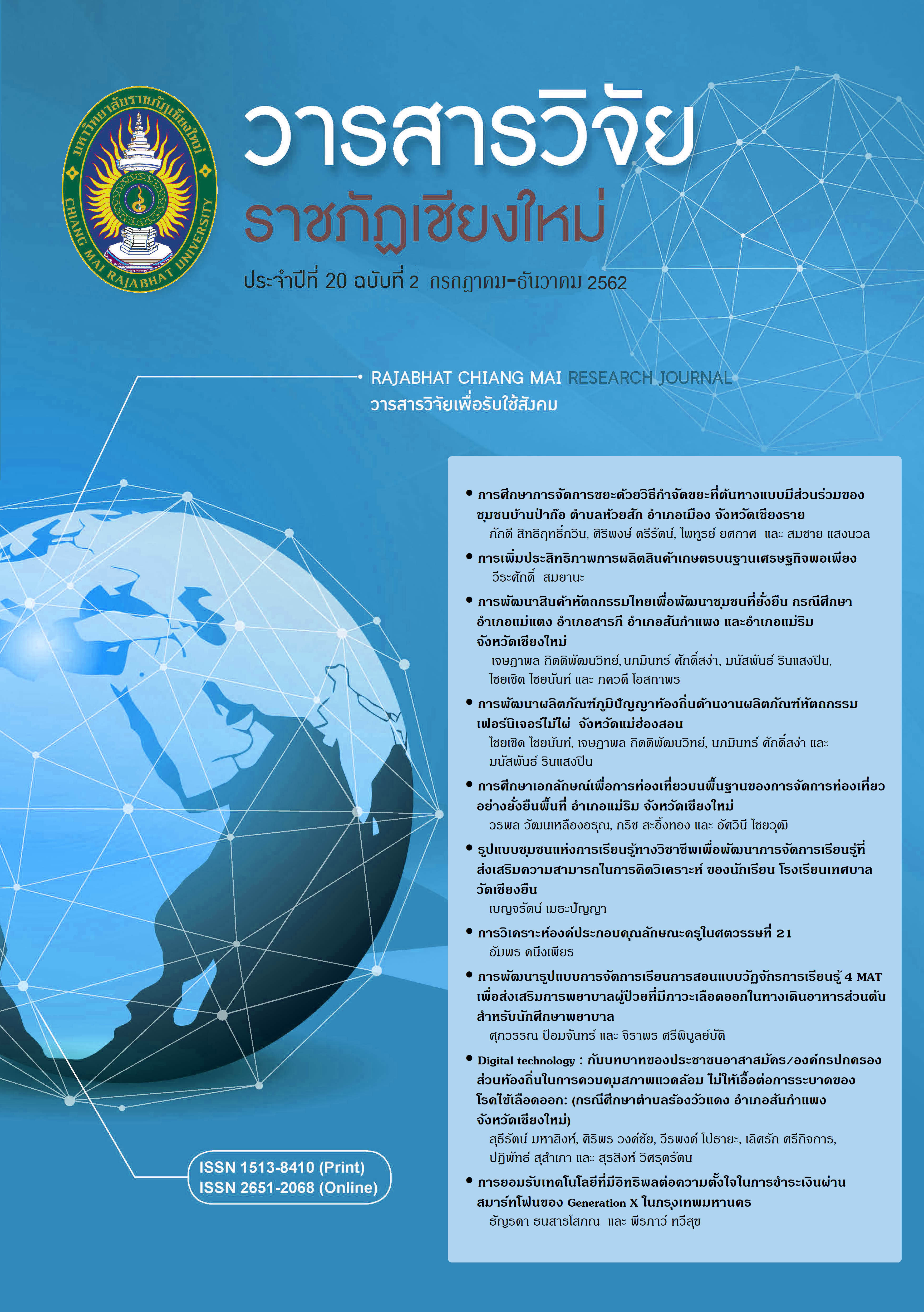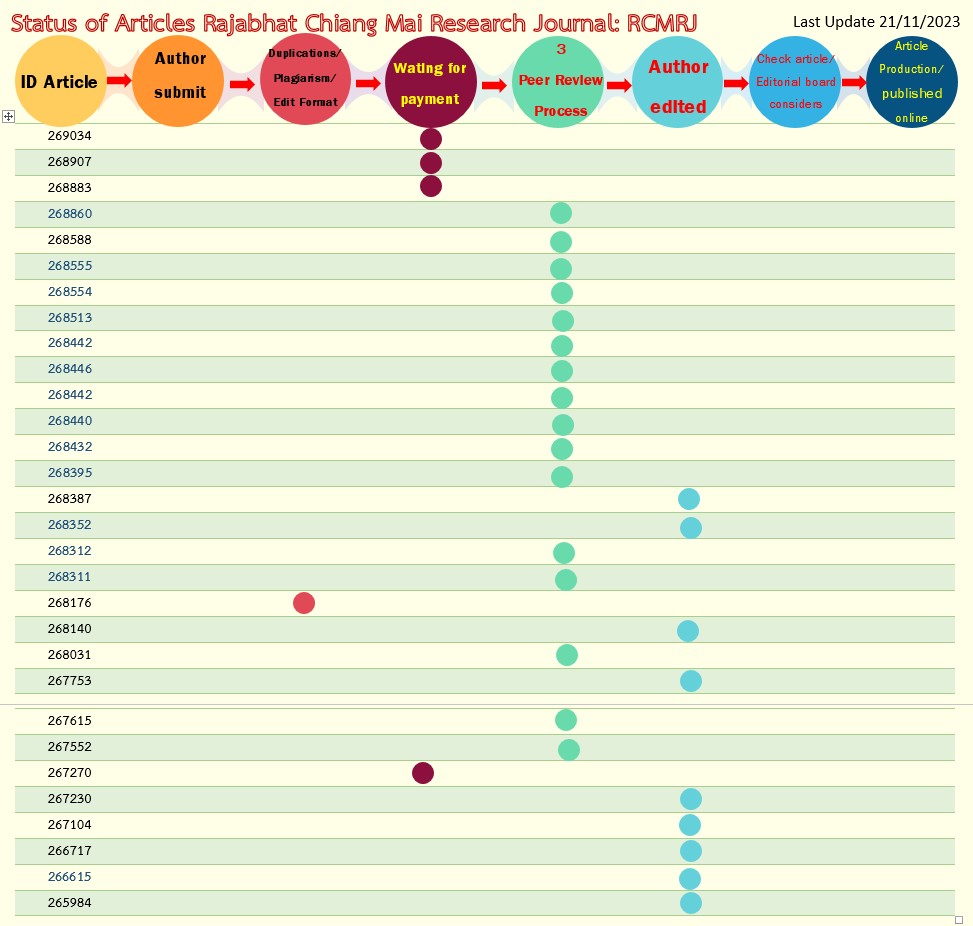teacher characteristic in the 21 Factor Analysis of Teacher Characteristic in the 21st Century
DOI:
https://doi.org/10.14456/rcmrj.2019.205538Keywords:
Factor analysis, Teacher characteristic, The 21st centuryAbstract
The purposes of this research were factor analysis of teacher characteristic in the 21st century and perform a confirmatory factor analysis of teacher characteristic in the 21st century on hypothesis model with empirical data. The sample consisted of 691 subjects comprised students, teachers, parents of students and school board of Surawittayakarn School Surin of academic year 2018. The research instrument was teacher characteristic in the 21st century questionnaires; five-rating scale; 12 Latent variables; 82 Observable variables.
1. The teacher characteristic in the 21st century questionnaires were 12 Latent variables, i.e. Using innovation and technology, Good personality, Communication skills, Expertise In measurement and evaluation, Curriculum development, Classroom management, Self-development Cooperation And leadership. The construct validity was verified by one-order confirmatory factor analysis and found that the 12 model was consistent with empirical data.
2. The construct validity was verified by second-order confirmatory factor analysis and found that the 12 model was consistent with empirical data. The chi – square goodness of Fit (Chi Square) was 5849.318, the DF was 2173 , the p-value (P) was 0.00 , The Goodness-of –Fit Index (GFI) was 0.815, The Adjusted Goodness –of- Fit Index (AGFI) was 0.724 , The Normed Fit Index (NFI) was 0.902 , The Incremental Fit Index (IFI) was 0.936 , The Comparative Fit Index (CFI) was 0.935 , The Tucker – Lewis Index (TLI) was 0.905 , The Root Mean Square Error of Approximation (RMSEA) was 0.050.
References
กัลยา วาณิชบัญชา. (2557). การวิเคราะห์สมการโครงสร้าง (SEM) ด้วย AMOS . กรุงเทพฯ: ศูนย์หนังสือแห่งจุฬาลงกรณ์มหาวิทยาลัย.
จิรยา ภูพันนา และคณะ. (2556). คุณลักษณะของครูคณิตศาสตร์ในยุคศตวรรษที่ 21 ที่นักเรียนต้องการ . รายงานการวิจัย. มหาวิทยาลัยมหาสารคาม.
นพดล สร้อยนาค. (2551). คุณลักษณะที่พึงประสงค์ ของครูในทรรศนะของผูปกครองใน ตำบลแม่สาบ อำเภอสะเมิง จังหวัดเชียงใหม่. วิทยานิพนธ์ครุศาสตร์มหาบัณฑิต สาขาบริหารการศึกษา มหาวิทยาลัยราชภัฏสวนดุสิต.
ปรีชา ทดแทน. (2553). คุณลักษณะของครูที่พึงประสงค์ ตามการรับรู้ของนักเรียนชั้นประกาศนียบัตรวิชาชีพ โรงเรียนจอมเทียนบริหารธุรกิจ. งานนิพนธ์ปริญญาการศึกษามหาบัณฑิต สาขาการบริหารการศึกษา มหาวิทยาลัยบูรพา.
พิณสุดา สิริรังธศรี. (2557). การยกระดับครูไทยในศตวรรษที่ 21. พิมพ์ครั้งที่ 1. กรุงเทพฯ บริษัทมาตาการพิมพ์จำกัด.
ลัดดาวัลย์ สืบจิต. (2556). การพัฒนาตัวบ่งชี้สมรรถนะครูในศตวรรษที่ 21 สำนักงานคณะกรรมการการศึกษาขั้นพื้นฐาน. ปริญญานิพนธ์ดุษฎีบัณฑิต การบริหารการศึกษา มหาวิทยาลัยราชภัฏมหาสารคาม.
สำนักงานคณะกรรมการการศึกษาขั้นพื้นฐาน. (2553). คู่มือการประเมินสมรรถนะครู. กรุงเทพฯ. สำนักงานคณะกรรมการการศึกษาขั้นพื้นฐาน.
สำนักงานเลขาธิการคุรุสภา. (2556). มาตรฐานวิชาชีพครู. กรุงเทพฯ: สำนักมาตรฐานวิชาชีพสำนักงานเลขาธิการครุสภา.
สุเทพ ธรรมตระกูล และอนุวัติ คูณแก้ว. (2555). การศึกษาคุณลักษณะของครูยุคใหม่. รายงานการวิจัย. มหาวิทยาลัยราชภัฏเพชรบูรณ์.
สุพรทิพย์ ธนภัทรโชติวัต. (2556). การพัฒนารูปแบบการจัดประสบการณ์วิชาชีพครูเพื่อส่งเสริมคุณลักษณะครูในศตวรรษที่ 21. วิทยานิพนธ์ปริญญาการศึกษาดุษฎีบัณฑิต สาขาหลักสูตรและการสอน มหาวิทยาลัยนเรศวร.
Andrew Churches. (2008). Bloom's Digital Taxonomy. Retrieved from http://burtonslifelearning.pbworks.com/f/BloomDigitalTaxonomy2001.pdf
Hafsah Jan. (2017). Teacher of 21st Century: Characteristics and Development. D Scholar, School of Education & Beharioural Sciences, University of Kashmir.
Downloads
Published
How to Cite
Issue
Section
License
1. Articles, information, content, images, etc. that are published in "Chiang Mai Rajabhat Research Journal" is the copyright of Chiang Mai Rajabhat Research Journal. Chiang Mai Rajabhat University. If any person or organization wants to distribute all or any part of it or do any action Must have written permission from the Chiang Mai Rajabhat Research Journal, Chiang Mai Rajabhat University.
2. Content of articles appearing in the journal is the responsibility of the author of the article. The journal editor is not required to agree or take any responsibility.














